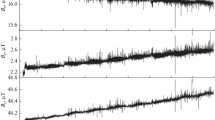Summary
Since November 1984 a regional study of the Earth's magnetic field has been carried out, measuring absolute values ofF, D, andI. The aim is to find the behaviour of the secular variation at about 40 field sites with maximum distances of 50 km from Göttingen. After a long search for the least disturbed points, the first set of measurements was taken in 1987. For the reduction according to the normal 2h UT level the Göttingen observatory (GTT) records are used for each field point. However, by comparing the simultaneously registered magnetic values of the observatories Wingst (WNG) and GTT it turned out that there is an annual periodic drift in the GTT registrations. Besides the temperature coefficients of the variometers the whole micro-climate of temperature and humidity inside and outside the building and of the underground has to be considered. It causes a motion of the bottom plate (on which the variometers are standing) relative to the foundations of the walls (which house the camera and the lamps for the photographic registration). These motions can be misinterpreted as long period magnetic variations. Variations of the micro-climate and consequently the time dependence of the motions cannot be predicted. Apparently the long-term stability of the whole recording system, which is essential for reducing regional measurements and for the investigation of the secular variation, had not been considered important as the building was set-up. To overcome that lack of stability two ways are necessary: firstly, to perform regular absolute measurements at the observatory (more than once a week) to get a better knowledge of the base line of each component, secondly, to refer the GTT registrations to the momentary values of WNG which are assumed to be stable, to get by this way a proper reduction of the field measurements.
Zusammenfassung
Seit November 1984 wird das regionale Erdmagnetfeld in der Umgebung von Göttingen mit Absolutinstrumenten fürF, D undI vermessen. Das Ziel einer solchen Vermessung ist die Untersuchung der Säkularvariation an 40 Punkten mit einer maximalen Entfernung von 50 km von Göttingen. Nach einer längeren Suche nach den am wenigsten gestörten Punkten wurde 1987 mit den Messungen begonnen. Für die Reduktion aller Meßwerte auf 2h UT und auf einen bestimmten Tag im Jahr wurden die photographischen Registrierungen des Observatoriums Göttingen (GTT) benutzt. Durch Vergleich der gleichzeitig in den Observatorien Wingst (WNG) und GTT abgelesenen Momentanbeobachtungen der Magnetfeldkomponenten zeigte sich aber, daß der Säkularvariation in GTT eine starke Jahreswelle überlagert ist. Verursacht wird diese Jahreswelle offenbar durch eine Relativbewegung der zwei Fundamente der Meßhütte: Die Fundamentplatte (auf der die Variometer stehen) bewegt sich gegenüber dem Fundament der Wände (in die Registrierkamera und die Lampen eingelassen sind). Auf der Registrierung können diese Bewegungen fälschlicherweise als Magnetfeldvariation mit langer Periode gedeutet werden. Änderungen des Mikroklimas (Temperatur und Feuchte) innerhalb und außerhalb der Meßhütte, das für diese Bewegungen verantwortlich ist, sind nicht vorhersehbar. Offenbar ist die Langzeitstabilität der Aufzeichnungsapparatur, die auch eine Untersuchung der Säkularvariation ermöglichen würde, bei der Konstruktion der Meßhütte noch nicht wichtig gewesen. Um dennoch eine vernünftige Reduktion zu erzielen, ist es nötig, öfter als einmal wöchentlich die Absolutwertbestimmung in GTT durchzuführen und damit die Basis jeder Magnetfeldkomponente zu bestimmen, und zweitens zu versuchen, die Zeiten zwischen zwei Absolutwertbestimmungen mit den Momentanwerten aus WNG zu überbrücken.
Résumé
Depuis novembre 1984, une étude régionale du champ magnétique terrestre a été menée afin de déterminer les valeurs absolues deF, D etI. le but visé est de déterminer l'évolution de la variation séculaire sur environ quarante sites situés à une distance maximale de 50 km de Göttingen. Après une longue recherche des points les moins perurbés une première série de mesures a pu être effectuée en 1987. Pour la réduction rapportée à la valeur normale à 2h UT, les enregistrements de l'observatoire de Göttingen (GTT) furent utilisés pour chaque site.
En comparant les valeurs magnétiques enregistrées simultanément à l'observatoire de Wingst (WNG) et à GTT, il apparut qu'il existait une dérive annuelle périodique dans les enregistrements de GTT. Outre les coefficients de température des variomètres, l'ensemble des paramètres température et humidité du micro-climat, à l'intérieur et à l'extérieur de la station ainsi qu'en sous-sol dut être pris en compte. Ces derniers causent un déplacement de l'embase (sur laquelle les variomètres sont installés) par rapport aux fondations des murs (qui abritent la caméra et les flashs pour l'enregistrement photographique): Ces mouvements peuvent être interprétrés à tort comme des variations à longue période du champ magnétique.
Les variations du micro-climat et partant, la dépendance de ces mouvements en fonction du temps, ne peuvent se prévoir. Apparemment la stabilité á long terme de l'ensemble du système d'enregistrement, qui est essentielle pour la réduction des mesures régionales et pour l'étude de la variation séculaire, n'avait pas été condiérée comme importante au moment de la construction de la station.
Pour palier ce manque de stabilité deux solutions sont possibles: Tout d'abord réaliser régulièrement des mesures absolues à l'observatoire (plus d'une par semaine) afin d'obtenir une meilleure connaissance de la valeur instantanée de la direction de chaque composante, ensuite rattacher les enregistrements de GTT aux valeurs déterminées à WNG, supposées stables, pour obtenir ainsi une réduction correcte des mesures de champs.
Similar content being viewed by others
References
Mundt, W., 1981: Regionale und lokale Anomalien der geomagnetischen Säkularvariation im Randbereich der Osteuropäischen Tafel. Z. geol. Wiss. Berlin9, 1173–1178.
Voppel, D. und K. Wienert, 1974: Die geomagnetische Vermessung der Bundesrepublik Deutschland, Epoche 1965.0. Dt. hydrogr. Z.27, 49–56.
Author information
Authors and Affiliations
Rights and permissions
About this article
Cite this article
Spitta, P. Base line stability of the magnetic main registration at the Göttingen observatory. Deutsche Hydrographische Zeitschrift 41, 145–157 (1988). https://doi.org/10.1007/BF02225924
Received:
Published:
Issue Date:
DOI: https://doi.org/10.1007/BF02225924




